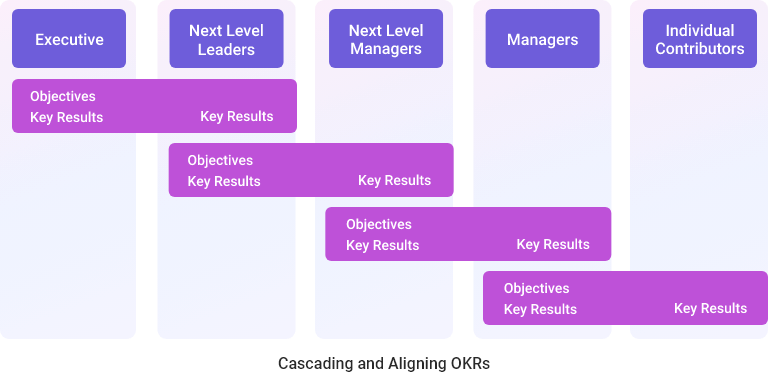February 6, 2023
Mastering the Art of Aligning with OKRs

Out of the four OKR superpowers that make OKRs what they are, alignment is the second after focus. As a business leader, you want individuals and teams in your organization to focus on the company’s goals and thus accelerate their strategic performance. But focusing isn’t enough. In today’s times, your workforce sees siloing of work. They are unaware of what other teams and departments are working on. There is no transparency. The worst part is your employees fail to understand how their daily goals contribute to the overarching organizational goals. All this happens due to the absence of alignment.
Why do we need alignment in the first place?
- Decision-making is the most important in an organization. If you are a well-aligned organization, you can make quicker decisions. Implementing those decisions also takes less time. Most importantly, your employees perform better when they are aligned.
- Alignment helps to mitigate the costs of resources, furthering growth.
- As individuals’ key results (KRs) align with your organization’s strategy, they become more engaged and effective in their performance.
- Alignment also brings in improved self-governance. Employees get clarity on priorities, tasks, and decisions.
- Aligned organizations have mechanisms in place, guaranteeing processes deliver invariably, as per the expectations of clients and external stakeholders.
Ways to Achieve Team Alignment
Top-down Approach

In the context of OKRs, top-down alignment means cascading your key result as a KR to the next-level direct report. Talking about a typical top-down approach, the manager plans for and sets the objectives for the OKR. One or more executive KRs may become the leader’s key results next-in-line, and this goes on. Let us take an OKR example to understand the cascading effect better.
Objective: Expand the business faster to emerge as a sustainable business leader
Key Result 1: Increase bookings from $150M to $230M
Key Result 2: Retain 86% of gross revenue
Key Result 3: Generate $970M Annual Recurring Revenue (ARR)
Vice President, Global Sales
Objective: Share value to increase the customer base
Key Result 1: Increase bookings from $150M to $230M
Key Result 2: 50% win rate improved from 40%
Key Result 3: 25% of booking from upsells
Remember, in an OKR tool, after you have assigned the key result as a KR, the progress made at the KR level connects to the aligned KR’s progress.
Key Takeaway
It pays to be the owner of an OKR. As you assign a KR to your direct report next in line, you add to your progress in achieving that key result and align KRs to accomplish the end goals.
Bottom-up Approach

In an OKR framework, alignment may also come from the bottom up. An individual working in the organization may better understand customers’ beliefs and thoughts. This may not necessarily reach the executive level. But, as you employ UnlockTalent product in your organization, individuals can align with people in their teams or cross-functional teams, thus adding their key result as a KR to one or more of others’ objectives.
Besides, the new “conversation module” in UnlockTalent goal-setting software assists you in exchanging communication among the different employees within the organization, preferably the user, team manager, and contributor(s) as text comments, about any given OKR.
Key Takeaway
Individual contributors are empowered and can add their managers and leaders as contributors to achieve their key results faster. As they do so, there is easy goal accomplishment.
The Magic of Superordinate Goals
Highly aligned companies grow revenue 58% faster and are 72% more profitable compared to their misaligned counterparts.*
With a smart goal-setting framework, you can align individuals and teams better. You create superordinate goals when you set objectives and key results at the company level. Besides, superordinate goals precede all other types of goals and goals at a lower level. You can accomplish this goal only if the members of two or more groups collaborate while pooling their talent, resources, skills, and efforts. As you create organization-level OKRs and superordinate goals, teams competing for resources share a common goal. The aim here is to foster more cross-communication and collaboration, thus leading to more alignment.
In addition, when organizational processes have clarity and transparency, there is an improved alignment. With clear expectations on what you desire in the planning and execution phases, stay aligned, hold that process, and continue with the flow.
Are you making the most of alignment?
- Make sure your teams participate in the planning phase of the OKR cycle to plan superordinate goals.
- Find out if individuals and teams contribute and how they achieve the team or department goal.
- Check if there is enough communication taking place through team meetings.
- Employ a simple, easy-to-use UnlockTalent product and learn how individuals and teams progress on their goals and where they lag.
- The end goal should be to maximize execution and increase strategic performance to accomplish your goals faster.
*https://lsaglobal.com/insights/proprietary-methodology/lsa-3x-organizational-alignment-model/
